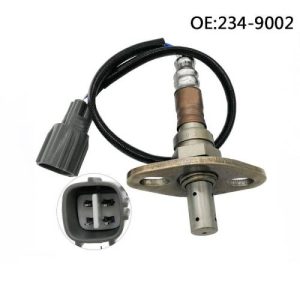Your cart is currently empty!
What Does an Oxygen Sensor Do? The Essential Guide for Car Owners
Understanding the Vital Role of Oxygen Sensors
What does an oxygen sensor do in your vehicle? This critical component, often called an O2 sensor, acts as your engine's chemical analyst, continuously monitoring exhaust gases to optimize combustion efficiency. Modern vehicles rely on this unsung hero to balance power output, fuel economy, and emission control - three pillars of automotive performance that directly impact both your driving experience and environmental footprint.

What Does an Oxygen Sensor Do? Anatomy and Function
Positioned upstream and downstream of the catalytic converter, an oxygen sensor contains a zirconium dioxide ceramic element heated to 600°F (316°C). When exposed to exhaust flow, it generates voltage signals (0.1-0.9V) corresponding to oxygen levels. The engine control module (ECM) uses this real-time data to adjust fuel injection duration within milliseconds, maintaining the ideal air-fuel ratio of 14.7:1. This precise regulation enables complete combustion while ensuring catalytic converter efficiency.
Real-World Impact: A Mechanic's Case Study
Sarah's 2016 Honda CR-V presented with a 23% fuel economy drop and P0172 "System Too Rich" trouble code. Diagnostic data revealed Bank 1 Sensor 1 (pre-catalytic) oxygen sensor voltage stuck at 0.85V, falsely indicating lean conditions. This caused continuous over-fueling, damaging spark plugs and overworking the catalytic converter. After replacement, fuel trim values normalized from +25% to ±3%, restoring EPA-estimated 29 MPG highway performance.

Symptoms of Oxygen Sensor Failure
- Check Engine Light (CEL) with codes P0130-P0167
- Rough idle (RPM fluctuation exceeding ±50)
- Fuel smell from exhaust (HC emissions above 100 ppm)
- Catalytic converter overheating (temps exceeding 1,600°F)
- 20-40% reduction in fuel efficiency
Replacement Process and Results
Technicians follow a precise 7-step protocol: 1) Locate sensor using service manual diagrams 2) Apply penetrating oil to corroded threads 3) Use 22mm crowfoot O2 sensor socket 4) Install new sensor with anti-seize compound 5) Torque to 30 N·m (22 lb-ft) 6) Clear ECM adaptive memory 7) Road test with scan tool monitoring. Proper installation typically reduces NOx emissions by 63% and restores factory fuel curves within 15 drive cycles.
Technical Analysis: Sensor Failure Mechanisms
Three primary failure modes affect oxygen sensors: 1) Silicone contamination from RTV sealants (blocks gas diffusion) 2) Lead poisoning from improper fuel additives 3) Thermal shock from cold water contact. Wideband air-fuel ratio sensors (AFR sensors) introduce additional failure points including heater circuit faults and reference air channel blockages. Diagnostic best practices require analyzing both voltage signals and switching frequency (healthy sensors toggle 1-5 times/second at idle).
Sensor Types and Technological Evolution
Modern vehicles employ two distinct oxygen sensor technologies:
Narrowband Sensors: Binary rich/lean indicators (0-1V)
Wideband Sensors: Linear 0-5V output for precise AFR measurement
Titanium dioxide sensors offer faster response times (100ms vs 300ms zirconia) while planar sensors integrate heating elements for immediate post-startup operation. Current models like Bosch LSU 4.9 sensors achieve 0.01λ accuracy across 0.7-1.3 AFR ranges.
Key Takeaways: What Does an Oxygen Sensor Do?
Understanding what an oxygen sensor does reveals its dual role as both environmental guardian and performance enhancer. By maintaining stoichiometric combustion, it:
• Reduces CO emissions by 95% compared to open-loop operation
• Prevents catalytic converter meltdown ($1,200+ repair)
• Maintains EPA-compliant fuel economy
Regular replacement at 80,000-100,000 mile intervals preserves these benefits.
Maintenance Tips for Optimal Performance
- Use OEM or ISO 9001-certified replacement sensors
- Never apply thread sealants - use nickel-based anti-seize only
- Diagnose root causes before replacement (exhaust leaks? fuel issues?)
- Monitor long-term fuel trims (acceptable range: ±10%)
- Perform live data checks during annual inspections
By understanding what an oxygen sensor does and following these guidelines, you'll ensure your vehicle operates at peak efficiency while minimizing its environmental impact. Remember - this small component carries big responsibilities in your car's ecosystem.

Leave a Reply